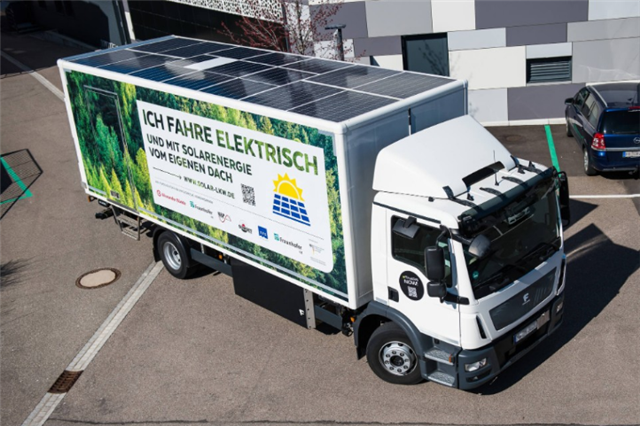A heavy-duty truck weighing 18 tons and equipped with a 3.5 kilowatt-peak photovoltaic system is now driving on Germany’s roads. The commercial vehicle with integrated high-voltage photovoltaic system and feed-in to the 800-volt traction battery has been approved for road traffic. The solar power produced directly on the vehicle can cover 5 to 10 percent of the truck’s energy needs.

The solar modules integrated into the box body make full use of the entire roof. Photo: Fraunhofer ISE
In the Lade-PV project, the Fraunhofer Institute for Solar Energy Systems ISE, with its project partners from industry and the Fraunhofer Institute for Transportation and Infrastructure Systems IVI, has developed solar PV modules and power electronics for integration in commercial vehicles. This truck, the first equipped with these PV modules, has now passed the technical inspection, marking a milestone towards more climate-friendly road freight transport.
“By successfully putting our high-voltage photovoltaic system into operation, we have achieved our goal of demonstrating the feasibility of vehicle-integrated photovoltaics for heavy-duty electric utility vehicles. The technical components integrated into the truck function as we expected,” remarks Christoph Kutter, project manager at Fraunhofer ISE. The particularly lightweight and robust PV module prototypes were developed by Fraunhofer ISE and built by Sunset Energietechnik GmbH. TBV Kühlfahrzeuge GmbH integrated the new modules into the box body of a Framo electric truck, which serves as the first demonstrator vehicle.
Safe Power Management Thanks to Separation Device
To ensure that the electricity yields are high and the material and cabling costs are low, the solar modules in the truck roof are connected in series. The resulting high voltages of up to 400 volts could pose a safety risk in the event of an accident. To prevent this risk, Fraunhofer ISE has developed a separation device, which is located in the junction box of each PV module. In the event of an accident, the device disconnects the power within milliseconds, so that only harmless, low protective voltages are present throughout the system.
Power Electronics Developed for Use in Vehicles
As with the PV modules, the power electronics were also adapted to the requirements of the commercial vehicle. Project partner M&P Motion Control and Power Electronics GmbH developed a DC power controller that communicates with the vehicle control system via CAN bus and is integrated into the vehicle’s safety concept. The photovoltaic power generated on the roof is fed directly into the on-board power supply of the commercial vehicle.
One-Year Test Under Real-life Conditions
The truck with integrated photovoltaic system will be used in the Freiburg area daily by the company Alexander Bürkle GmbH. The truck’s operation will be regularly tested for one year to validate the electricity yield forecast and monitor the components under real conditions. Also, the energy forecast model “IVImon” of Fraunhofer IVI will accompany the truck on all routes throughout the year. This model forecasts the range, charging times and power generation for different routes depending on the vehicle consumption and the solar radiation.
Vehicle-integrated photovoltaics has gained increasing interest in science and industry in recent years, also with respect to heavy-duty and commercial vehicles. From December 6-8, 2021, the first international conference dedicated to the topic will be held online.


